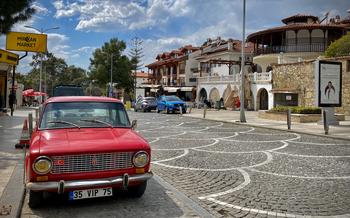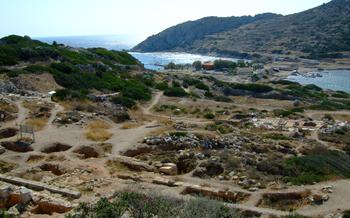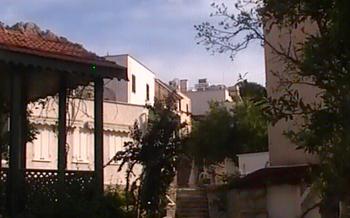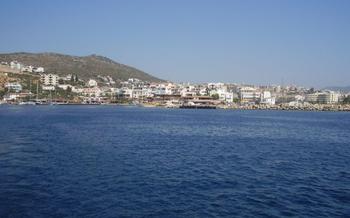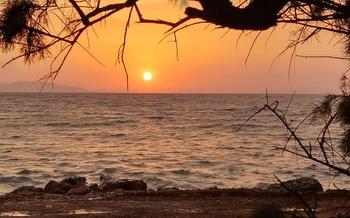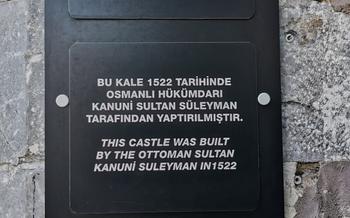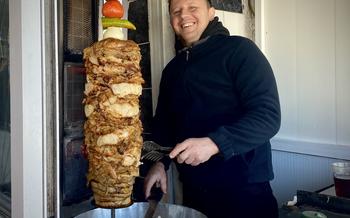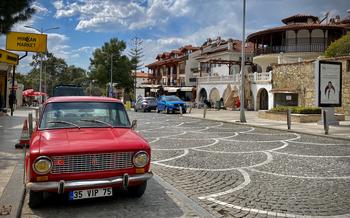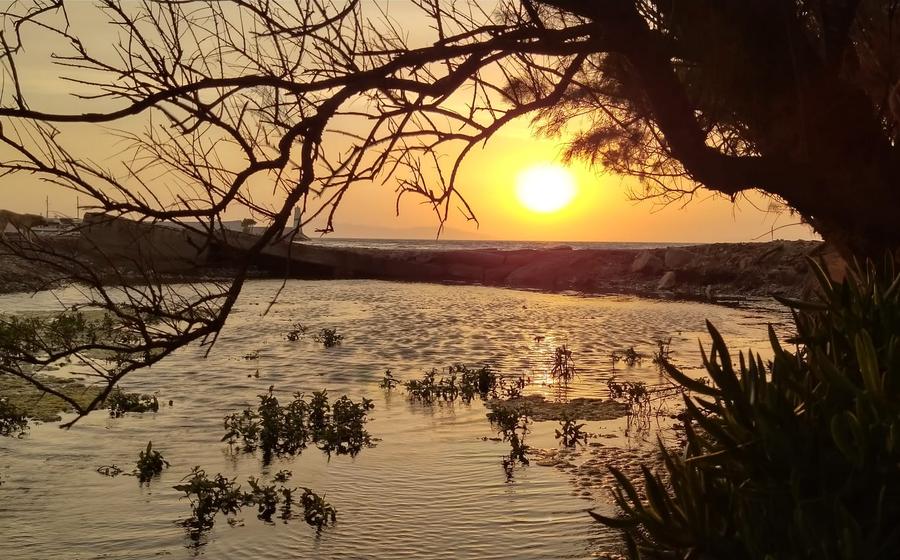
Hekatomnus Mausoleum
- Hekatomnus Mausoleum: A Masterpiece of Ancient Architecture
- Location and Accessibility: Finding the Hekatomnus Mausoleum
- Exploring the Mausoleum: Unveiling Its Secrets
- Historical Context: The Mausoleum's Place in History
- Architectural Wonders: Exploring the Mausoleum's Design
- Cultural Significance: The Mausoleum's Legacy
- Local Myths and Legends: Stories Surrounding the Mausoleum
- Tips for Visitors: Making the Most of Your Visit
- Photography Tips: Capturing the Beauty of the Mausoleum
- The Mausoleum in Popular Culture: References and Depictions
- Restoration and Conservation Efforts: Preserving the Mausoleum's Legacy
- Visiting Datça: Exploring the Town and Its Surroundings
- Practical Information: Planning Your Trip to the Mausoleum
- Sustainable Tourism: Responsible Travel in Datça
- Insider Tip: Unveiling the Hidden Gem of Knidos
Hekatomnus Mausoleum: A Masterpiece of Ancient Architecture
The Hekatomnus Mausoleum stands as a testament to the architectural prowess and cultural significance of the ancient city of Datça in Turkey. Built in the 4th century BC as a final resting place for the satrap of Caria, Hekatomnus, this monumental structure showcased a blend of Greek and Egyptian architectural influences. The mausoleum's imposing facade, adorned with intricate carvings and sculptures, reflects the wealth and power of the Hekatomnus dynasty. Its well-preserved interior, featuring a grand chamber and a finely crafted sarcophagus, offers a glimpse into the burial practices of the ancient Carian rulers. The Hekatomnus Mausoleum remains an iconic symbol of Datça's rich history and cultural heritage, attracting visitors from around the world who marvel at its architectural grandeur and historical significance.
Location and Accessibility: Finding the Hekatomnus Mausoleum
The Hekatomnus Mausoleum resides within the modern-day town of Datça, a charming coastal town situated along Turkey's southwestern coast. This picturesque town is easily accessible by land, sea, or air.
Reaching Datça by Land:
-
From major cities like Izmir or Antalya, hop on a comfortable bus or rent a car for a scenic road trip along the breathtaking Turkish Riviera.
-
The journey by bus takes approximately 4-6 hours, while driving offers the freedom to explore the stunning coastal landscapes at your own pace.
Arriving by Sea:
- If you prefer a more leisurely journey, take a ferry from the nearby Greek island of Kos. The ferry ride offers panoramic views of the Aegean Sea and takes about 5 hours.
Visiting the Mausoleum:
-
Once in Datça, the Hekatomnus Mausoleum is conveniently located within the town center, making it easily accessible on foot.
-
Plan your visit during the mausoleum's opening hours, typically from 8 am to 6 pm daily.
-
Admission fees are minimal, allowing you to explore this ancient wonder without breaking the bank.
Insider Tip:
- For an immersive experience, consider visiting during the off-season (November to March) to avoid the crowds and enjoy the tranquility of the site.
Exploring the Mausoleum: Unveiling Its Secrets
The imposing facade of the Hekatomnus Mausoleum is adorned with intricate carvings that depict scenes from Greek mythology and the life of Hekatomnus himself. The details on the facade are remarkably well-preserved, allowing visitors to appreciate the skill and artistry of the ancient craftsmen. Step inside the mausoleum, and you are greeted by a mysterious and awe-inspiring atmosphere. The interior chamber is vast and dimly lit, with a high ceiling supported by massive columns. In the center of the chamber lies the well-preserved sarcophagus of Hekatomnus, carved from a single block of marble and adorned with intricate reliefs. The sarcophagus is a testament to the opulence and power of the Hekatomnus dynasty.
Other artifacts and inscriptions found at the mausoleum provide valuable insights into the history and culture of ancient Caria. These artifacts include pottery fragments, jewelry, and coins, as well as inscriptions in both Greek and Carian scripts. The inscriptions record the names of Hekatomnus and his family members, as well as their accomplishments and lineage. These inscriptions are invaluable sources of information for historians and archaeologists, helping to piece together the story of this ancient civilization.
Historical Context: The Mausoleum's Place in History
The Hekatomnus Mausoleum stands as a testament to the rich history and cultural heritage of Caria, an ancient region located in southwestern Turkey. Caria was ruled by a dynasty of satraps, or governors, under the Persian Empire. Hekatomnus, the founder of the dynasty, reigned from 391 to 377 BC and played a crucial role in establishing Caria's autonomy and prosperity.
The mausoleum, built as Hekatomnus's final resting place, reflects the power and wealth of the Hekatomnus dynasty. It is believed to have been constructed between 350 and 330 BC, during the reign of Hekatomnus's son, Mausolus. Mausolus expanded the kingdom's territories and commissioned several ambitious building projects, including the famous Mausoleum at Halicarnassus, one of the Seven Wonders of the Ancient World.
The Hekatomnus Mausoleum is often compared to the Mausoleum at Halicarnassus, as both structures showcase the architectural prowess of the Carian rulers. The Mausoleum at Halicarnassus, however, was larger and more elaborate, featuring intricate sculptures and a stepped pyramid roof.
Despite its smaller size, the Hekatomnus Mausoleum holds significant historical value. It predates the Mausoleum at Halicarnassus and provides valuable insights into the architectural styles and funerary practices of the ancient Carians. The mausoleum's well-preserved condition makes it an important site for studying the history and culture of this ancient civilization.
In recent years, the Hekatomnus Mausoleum has undergone extensive restoration and conservation efforts, aimed at preserving its structural integrity and safeguarding its historical significance for future generations.
Architectural Wonders: Exploring the Mausoleum's Design
The Hekatomnus Mausoleum is a remarkable example of ancient architecture, showcasing a unique blend of Greek and Egyptian elements. Its impressive size and scale, intricate carvings, and innovative construction techniques make it a masterpiece of architectural design.
The mausoleum's facade is adorned with intricate carvings and decorative motifs, showcasing the skill and artistry of ancient craftsmen. These carvings depict scenes from Greek mythology, including the battles of the gods and goddesses, as well as representations of animals and plants. The mausoleum's unique blend of Greek and Egyptian architectural elements is evident in the use of columns and capitals, which are typically associated with Greek architecture, and the stepped pyramid shape of the roof, which is a characteristic feature of Egyptian tombs.
The mausoleum's construction techniques were also innovative for its time. The use of large stone blocks, carefully fitted together without the use of mortar, demonstrates the engineering prowess of the ancient builders. The mausoleum's interior chamber is also notable for its impressive vaulted ceiling, which was constructed using a technique known as corbelling, where each layer of stone protrudes slightly over the one below it, creating a self-supporting structure.
The Hekatomnus Mausoleum stands as a testament to the architectural achievements of the ancient world, combining elements from different cultures to create a unique and awe-inspiring structure. Its intricate carvings, innovative construction techniques, and impressive size make it a must-see for anyone interested in ancient history and architecture.
Cultural Significance: The Mausoleum's Legacy
The Hekatomnus Mausoleum holds immense cultural significance, serving as a testament to the vibrant cultural exchange between Greece and Persia during antiquity. Its unique architectural features, blending elements from both civilizations, showcase the rich cross-pollination of ideas and artistic influences that shaped the region. The mausoleum's grandeur and opulence reflect the power and wealth of the Hekatomnus dynasty, symbolizing their enduring legacy and influence in the ancient world.
Moreover, the Hekatomnus Mausoleum has played a pivotal role in fostering cultural heritage and tourism in Datça. Its historical significance and architectural beauty have attracted visitors from far and wide, eager to witness this remarkable relic of the past. The mausoleum has become a symbol of Datça's rich history and cultural heritage, contributing to the town's identity and appeal as a tourist destination.
Furthermore, the mausoleum has stimulated ongoing research and scholarship, inspiring academics and historians to delve deeper into the history of Caria, the Hekatomnus dynasty, and the cultural dynamics of the ancient Mediterranean world. Excavations and studies at the site have yielded valuable insights into the architectural techniques, artistic styles, and funerary practices of the period, enriching our understanding of ancient civilizations.
The Hekatomnus Mausoleum, with its enduring cultural significance, serves as a bridge between the past and the present, connecting us to the rich tapestry of ancient history and inspiring us to appreciate the enduring legacy of human creativity and cultural exchange.
Local Myths and Legends: Stories Surrounding the Mausoleum
The Hekatomnus Mausoleum is steeped in local myths and legends that have been passed down through generations. One captivating tale revolves around Hekatomnus's daughter, Ada, who was known for her unwavering devotion to her father. According to legend, Ada refused to eat or drink after Hekatomnus's death, choosing instead to remain by his side within the mausoleum. It is said that her unwavering love and grief caused her to transform into a nightingale, forever singing plaintive melodies around the mausoleum, mourning the loss of her beloved father.
Another popular legend speaks of hidden treasures buried within the mausoleum. Locals whisper of a secret chamber beneath the mausoleum, filled with gold, jewels, and other riches amassed by the Hekatomnus dynasty. Many have attempted to uncover this hidden treasure, but none have succeeded, leading to the belief that the mausoleum is protected by a powerful curse.
Stories of hauntings and ghostly apparitions also surround the mausoleum. Some claim to have seen the spirits of Hekatomnus and his family wandering the grounds at night, their presence a testament to their enduring legacy. Others have reported hearing strange noises and voices emanating from the mausoleum, adding to its eerie atmosphere.
These local myths and legends have woven themselves into the fabric of the Hekatomnus Mausoleum, adding layers of intrigue and fascination to this ancient monument. They serve as reminders of the rich cultural heritage of Datça and the enduring power of stories to capture our imaginations and transport us to realms beyond the ordinary.
Tips for Visitors: Making the Most of Your Visit
To fully appreciate the Hekatomnus Mausoleum, plan your visit carefully and consider the following tips:
-
Timing is everything: Avoid the midday sun and crowds by visiting the mausoleum early in the morning or late in the afternoon. This will ensure a more peaceful and enjoyable experience.
-
Explore the surroundings: Combine your visit to the mausoleum with a stroll through the charming town of Datça. Explore its narrow streets, admire the traditional architecture, and savor delicious local cuisine at one of the many restaurants.
-
Uncover hidden gems: Don't miss the opportunity to visit other historical sites and attractions in the vicinity of Datça. Take a boat trip to the picturesque coves and beaches, or embark on a scenic hiking trail to discover hidden gems off the beaten path.
-
Engage with the locals: To truly immerse yourself in the local culture, interact with the friendly residents of Datça. Learn about their traditions, customs, and way of life. Supporting local businesses and initiatives will also contribute to the preservation of Datça's unique identity.
Photography Tips: Capturing the Beauty of the Mausoleum
The Hekatomnus Mausoleum offers a wealth of opportunities for photography enthusiasts to capture its architectural grandeur and historical significance. To make the most of your photographic journey, here are some tips to help you create stunning images:
-
Camera Settings and Angles: Choose a camera with a wide-angle lens to capture the mausoleum's imposing facade and intricate details. Experiment with different angles to find unique perspectives, such as shooting from a low angle to emphasize its height or from a distance to showcase its surroundings.
-
Natural Light: The mausoleum's beauty is enhanced by the natural light that illuminates its facade throughout the day. Visit during the golden hours of sunrise or sunset to capture warm and dramatic lighting conditions that bring out the texture and colors of the stone.
-
Creative Techniques: Use creative techniques to add depth and interest to your photographs. Try using a slow shutter speed to blur moving clouds or water in the background, creating a sense of movement and dynamism. Experiment with different filters or post-processing techniques to achieve unique and artistic effects.
-
Instagrammable Spots: The mausoleum offers several Instagrammable spots for capturing memorable shots. Stand in front of the mausoleum's entrance for a classic perspective, or find an elevated spot to capture the mausoleum amidst the surrounding landscape. Don't forget to share your photos using relevant hashtags to connect with other travelers and photography enthusiasts.
The Mausoleum in Popular Culture: References and Depictions
The Hekatomnus Mausoleum's enduring legacy extends beyond its historical and architectural significance, reaching into the realm of popular culture and artistic expression. The mausoleum has been featured in various forms of media, serving as a source of inspiration and fascination for artists, filmmakers, and writers.
In the world of cinema, the mausoleum has made notable appearances in several movies and television shows. The 2018 film "Tomb Raider" featured a scene where the protagonist, Lara Croft, explores the mausoleum in search of a hidden artifact. The popular Turkish TV series "Dirilis: Ertugrul" also included the mausoleum as a key location, showcasing its grandeur and historical importance.
The mausoleum has also been immortalized in literature, serving as the backdrop for thrilling adventures and historical narratives. In his book "The Seven Wonders of the Ancient World," renowned author and historian Matthew Reilly weaves a tale of intrigue and danger centered around the mausoleum.
Contemporary art and photography exhibitions have also featured the mausoleum, showcasing its architectural beauty and evocative atmosphere. Artists have been drawn to the mausoleum's unique blend of Greek and Egyptian elements, using it as a canvas for their creative expressions.
Moreover, the mausoleum's iconic status has led to its use as a symbol or motif in various cultural contexts. From postage stamps to video games, the mausoleum has become a recognizable symbol of Datça's rich history and cultural heritage.
These references and depictions in popular culture further solidify the Hekatomnus Mausoleum's place as a cultural icon, ensuring that its legacy continues to captivate and inspire generations to come.
Restoration and Conservation Efforts: Preserving the Mausoleum's Legacy
The Hekatomnus Mausoleum has undergone several restoration and conservation projects over the years to preserve its structure and integrity. The first major restoration effort took place in the 19th century, when the mausoleum was cleared of debris and its facade was repaired. In the 20th century, further restoration work was carried out, including the reconstruction of the mausoleum's roof and the consolidation of its walls.
In recent years, there has been a renewed focus on conserving the mausoleum. In 2015, a comprehensive restoration project was launched, which involved cleaning the mausoleum's exterior, repairing its stonework, and improving its drainage system. The project also included the installation of new signage and lighting to enhance the visitor experience.
Despite these efforts, the mausoleum continues to face challenges due to its age and environmental factors. The harsh Mediterranean climate, combined with the mausoleum's exposed location, has caused some deterioration to its structure over time. Additionally, the mausoleum is vulnerable to earthquakes, which are common in the region.
To address these challenges, local and international experts are collaborating to develop sustainable conservation strategies for the mausoleum. These strategies include using advanced technologies to monitor the mausoleum's condition, developing new conservation techniques, and raising awareness about the importance of preserving this ancient monument.
Funding and fundraising initiatives play a crucial role in supporting the mausoleum's restoration and conservation efforts. Donations from individuals, organizations, and government agencies help to cover the costs of these projects. By contributing to these initiatives, you can help to ensure that the Hekatomnus Mausoleum continues to stand as a testament to the rich history and cultural heritage of Datça.
Visiting Datça: Exploring the Town and Its Surroundings
Datça, the charming town where the Hekatomnus Mausoleum resides, offers a plethora of attractions beyond the ancient monument. Its old town exudes a timeless allure, with narrow cobblestone streets lined with traditional whitewashed houses, quaint shops, and inviting restaurants. History buffs can delve deeper into the town's rich past at the Datça Museum, showcasing artifacts and exhibits that narrate the region's captivating story.
Nature enthusiasts will find solace in the pristine beaches and secluded coves that dot Datça's picturesque coastline. Whether seeking tranquility or indulging in water sports, there's a perfect spot for every beachgoer. For those yearning for adventure, the surrounding mountains beckon with a network of hiking trails that wind through fragrant pine forests and offer breathtaking panoramic views.
Datça's cultural tapestry is vibrant and diverse, with festivals and events that celebrate the town's unique heritage. The annual Datça Olive Festival, held in November, is a joyous celebration of the region's olive-growing traditions, featuring local delicacies, traditional music, and lively dancing. The Datça International Short Film Festival, held in September, showcases a diverse array of short films from around the world, attracting film enthusiasts and filmmakers alike.
To immerse oneself fully in the local way of life, visitors can venture into the heart of the community by visiting the bustling farmers' market, where fresh produce, handmade crafts, and local specialties abound. Engaging in conversations with the friendly locals, savoring the delectable cuisine at family-run restaurants, and participating in traditional activities offer a glimpse into the authentic essence of Datça. This charming town promises an unforgettable experience, where history, nature, and culture harmoniously intertwine, leaving visitors with a deep appreciation for its timeless allure.
Practical Information: Planning Your Trip to the Mausoleum
Before embarking on your journey to the Hekatomnus Mausoleum, it's essential to gather practical information to ensure a smooth and enjoyable experience. Here are some key details to keep in mind:
-
Opening Hours and Admission Fees: The mausoleum is open to the public daily from 8:00 AM to 6:00 PM. Admission fees are typically minimal and may vary depending on the time of year.
-
Guided Tours: To delve deeper into the mausoleum's history and significance, consider booking a guided tour. Local tour operators and guides are available to provide insightful explanations and anecdotes about the site.
-
Transportation: Datça is well-connected by transportation from major cities in Turkey. Buses, trains, and flights are readily available, offering convenient options for reaching the town.
-
Accommodation: Datça offers a range of accommodation options to suit different budgets and preferences. From budget-friendly hostels to comfortable hotels and luxurious resorts, there's something for every traveler.
-
Food and Drink: Datça's culinary scene boasts a variety of restaurants and cafes serving delicious local cuisine. Enjoy fresh seafood, traditional Turkish dishes, and international fare while savoring the vibrant atmosphere of the town.
Sustainable Tourism: Responsible Travel in Datça
As you explore the Hekatomnus Mausoleum and the surrounding area, it's essential to embrace responsible tourism practices that preserve Datça's natural and cultural heritage. Here's how you can contribute to sustainable tourism in Datça:
-
Reduce Your Carbon Footprint: Opt for public transportation or rent a bicycle to minimize your carbon emissions. Consider carpooling or joining organized tours to reduce the number of vehicles on the road.
-
Respect Local Culture and Traditions: Dress modestly and behave respectfully in public places. Learn a few Turkish phrases to show your appreciation for the local culture. Support local businesses by shopping at traditional markets and dining at family-run restaurants.
-
Protect the Environment: Dispose of waste responsibly and avoid littering. Respect the natural environment by staying on designated trails and avoiding disturbing wildlife. Consider participating in beach clean-ups or other conservation initiatives.
-
Support Sustainable Businesses: Choose accommodation providers and tour operators committed to sustainable practices. Look for businesses that use renewable energy sources, reduce water consumption, and support local communities.
-
Educate Yourself and Others: Learn about Datça's unique heritage and the challenges it faces. Share your knowledge with others and encourage responsible tourism practices among your fellow travelers. By promoting sustainability, you can help protect the beauty and authenticity of Datça for future generations.
Insider Tip: Unveiling the Hidden Gem of Knidos
Venture beyond the Hekatomnus Mausoleum and discover the hidden gem of Knidos, an ancient city located just a short distance from Datça.
Immerse yourself in the captivating history and mythology of this once-thriving port city. Explore the remarkably well-preserved ruins of Knidos, including its impressive theater, where ancient dramas were once performed, and its sacred temples, where offerings were made to the gods. Marvel at the intricate mosaics and sculptures that adorn the city's buildings, transporting you back in time to the era of classical Greece.
As you wander through Knidos, let your imagination run wild as you envision the bustling streets, vibrant markets, and lively port that once characterized this ancient metropolis. Stand in awe of the city's fortifications, which once protected it from invaders, and soak in the breathtaking views of the Mediterranean Sea from its scenic location.
Knidos is a true hidden gem, offering a unique glimpse into the rich history and culture of the ancient world. Don't miss the opportunity to explore this fascinating site and uncover its many secrets during your visit to Datça.
